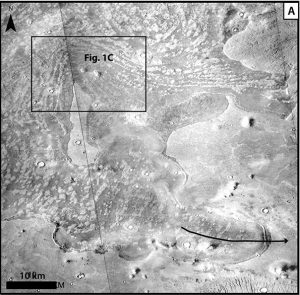29 March 2017
New study shows how impacts generated Martian tsunamis
Posted by Nanci Bompey
by Nanci Bompey

Thumbprint terrain showing a curvilinear pattern of high-albedo mounds, separated by low-albedo flat surfaces, and terminal lobate deposits (black arrow) in Arabia Terra.
Credit: American Geophysical Union
Thirty years ago, during a 3-month long visit to the U.S. Geological Survey in Arizona, Francois Costard saw Viking orbiter images of Mars’s northern plains showing strange curving features along the boundary between the Martian northern and southern hemispheres. Costard, a student in planetary science, thought these features and the deposits along them looked strange and wondered how they came to be.
“It was very curious and it was, for me, very impossible to interpret these landforms,” he said.
Three decades later, and now a scientist at CNRS in France, Costard shows how those strange landforms could be the remains of huge tsunamis.
A study published last year interpreted images of the red planet and suggested the deposits were made by impact-generated tsunamis more than 3 billion years ago. In a new study, Costard and his colleagues independently build on that work by including the geological characteristics of the deposits and modeling how impact-generated tsunamis could have created them. They conclude the deposits may have come from asteroids slamming into a northern ocean billions of years ago, generating waves 300 meters (nearly 1,000 feet) high.
The researchers also used detailed geological maps to show how these waves could be responsible for creating the so-called Thumbprint Terrain, a mysterious type of patterned ground resembling the lines on a human thumbprint.
“The only way to explain it is the tsunami hypothesis,” said Costard, lead author of the new study in the Journal of Geophysical Research – Planets, a publication of the American Geophysical Union.
The new study and the tsunami hypothesis lend support to the much-debated idea that Mars harbored a northern ocean billions of years ago, said Vic Baker, a planetary scientist at the University of Arizona who first proposed the idea in the early 1990s.
“Throughout the history of Mars’ investigation, the pendulum has always swung back and forth [in favor of a northern ocean] and this may just be another part of that interesting puzzle,” said Baker, who was not involved in the new study.
Simulating tsunamis on Mars
The new research simulated the height of the tsunami waves and their propagation direction, run-up elevation and distance for three potential sea levels and compared these models with the Martian deposits.
The study’s results suggest several potential impact craters, 30 to 50 kilometers (19 to 31 miles) in diameter, as the source of the tsunami events. The largest tsunami waves may have been 300 meters (984 feet) high – nearly as tall as the Eiffel Tower – following the impact, and waves up to 75 meters (246 feet) high – nearly as tall as the Statue of Liberty. The waves ultimately reached the Martian coast, potentially traveling up to 150 kilometers (93 miles) past the shoreline.
An initial tsunami wave formed by the water displaced by the impact, while a second wave arose from the collapse and re-flooding of the crater in the ocean and seafloor created by the impact, according to the study. Both waves eventually reached the Martian coast and generated multiple reflected and refracted waves that the new study suggests could have created the Thumbprint Terrain.
The continuing investigation
The new study reconciles different complex geological features of the Martian landscape to provide a mechanism for how they may have been generated. It is a good step in trying to understand the planet’s past and to support the idea of the existence of an ancient ocean on Mars, said Patrick Pinet, a planetary scientist at CNRS who was not involved in the new study.
The ultimate truth of what happened on the red planet 3 to 4 billion years ago is likely more complicated to prove, and will likely only be known if and when scientists extract Martian sediment cores, he said.
“It will be a huge amount of work once we are on Mars to come to definitive proof, but it looks good to me at the present level,” Pinet said.
— Nanci Bompey is the manager of AGU’s public information department.



 GeoSpace is a blog on Earth and space science, managed by AGU’s Public Information staff. The blog features posts by AGU writers and guest contributors on all sorts of relevant science topics, but with a focus on new research and geo and space sciences-related stories that are currently in the news.
GeoSpace is a blog on Earth and space science, managed by AGU’s Public Information staff. The blog features posts by AGU writers and guest contributors on all sorts of relevant science topics, but with a focus on new research and geo and space sciences-related stories that are currently in the news.